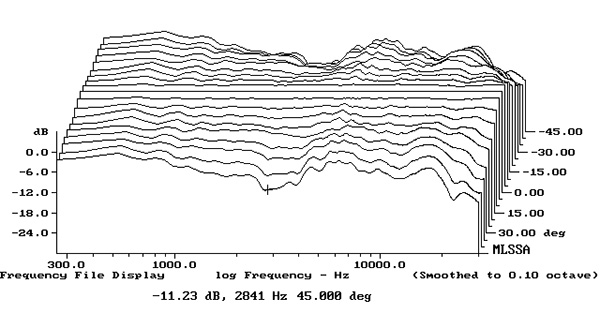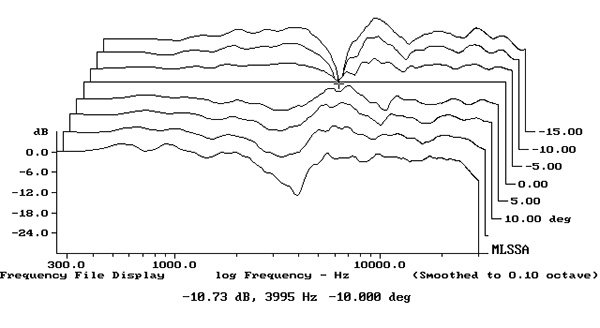| Columns Retired Columns & Blogs |
Figure 6 is incorrect, it shows the waterfall plot instead of the vertical response.
For logistical reasons, I measured one of the 801 D4 Signature speakers, serial number 2320 0004094 FP 44229, in Tom Fine's listening room rather than at my home. (My thanks to Tom and Mike Barney for moving furniture to allow me sufficient room for the measurements with the loudspeaker away from the walls and firing along a room diagonal.) I used DRA Labs' MLSSA system with a calibrated DPA 4006 microphone to measure the speaker's behavior in the farfield and an Earthworks QTC-40 mike for the nearfield responses. Because of the speaker's weight—almost 222lb—it wasn't possible to raise it off the floor. I therefore performed all the farfield measurements at a 1m microphone distance rather than my usual 50" to push back in time the reflections of the speaker's output from the floor. The measurements were performed with the vestigial grilles in place, as this was how TF had auditioned the 801 D4 Signatures.

B&W specifies the 801 D4 Signature's sensitivity as 90dB/2.83V/m, which was confirmed by my estimate of 89.8dB(B)/2.83V/m. I measured the loudspeaker's impedance with Dayton Audio's DATS V2 system. The 801 D4 Signature's impedance magnitude (fig.1, solid trace) lies between 3.5 ohms and 6 ohms through the upper bass and midrange, with a minimum value of 3.2 ohms at 90Hz. (The specified minimum impedance is 3 ohms.) However, the electrical phase angle (fig.1, dashed trace) is often high, meaning that the EPDR (footnote 1), or effective impedance, lies below 2 ohms between 52Hz and 107Hz and below 3 ohms between 310Hz and 418Hz, between 60Hz and 1750Hz, and above 5.5kHz. The minimum EPDR values are 1.24 ohms at 72Hz, 2.3 ohms at 362Hz, 1.62 ohms at 912Hz, and 1.82 ohms at 10.6kHz. The 801 D4 Signature has one of the most current-hungry impedances I have encountered, though this will be somewhat ameliorated by the above-average voltage sensitivity.

I investigated the woofer and midrange enclosure's vibrational behavior with a plastic-tape accelerometer. When I rapped the woofer enclosure's sidewalls with my knuckles, I heard a slight "plink" with a stethoscope, which correlated with a very low-level mode at 359Hz (fig.2). The midrange enclosure was completely inert.

The impedance-magnitude plot has a saddle centered on a low 28.5Hz, which suggests that this is the tuning frequency of the downward-firing port on the woofer cabinet's base. The two woofers behaved identically; the blue trace below 440Hz in fig.3 shows the sum of their nearfield responses, which has its minimum-motion notch at the expected 28.5Hz. The nearfield response of the port (red trace) peaks between 20Hz and 50Hz, and its initial upper-frequency rolloff is very clean. While there is a peak centered on 400Hz in its output, this lies 20dB below the peak output of the woofers. The woofers cross over to the midrange unit (green trace) just above the specified 400Hz, with a fast low-pass rolloff. The farfield output of the midrange unit and tweeter (green trace above 440Hz) appears to be balanced 3–5dB higher in level than that of the woofers and is relatively uneven, with a triple-humped response.
The black trace below 300Hz in fig.4 shows the sum of the nearfield midrange, woofer, and port outputs taking into account acoustic phase and the different distance of each radiator from a nominal farfield microphone position. The rise in response in the upper bass, which is due to the nearfield measurement technique, is lower in amplitude than usual. The 801 D4 Signature's low-frequency alignment appears to be optimized for definition; with the low tuning frequency of the port, boundary reinforcement will give extension to below 20Hz in a typical room. (B&W specifies the –6dB frequency as 13Hz.)

Bowers & Wilkins doesn't specify a recommended listening axis, so I took the farfield responses in figs.3 and 4 on the tweeter axis. However, as the tweeter is 47" from the floor and TF's ears with him sitting in his chair were closer to the midrange axis, which is 41.5" high, I performed response and lateral dispersion tests on both the tweeter axis and the midrange axis.
The black trace above 300Hz in fig.4 shows the B&W's farfield response, averaged across a 30° horizontal window centered on the tweeter axis. The red trace repeats the averaged response on the midrange axis. The overall balance on either axis favors the treble, with a slight lack of presence-region energy compared with the output above and below that region. I repeated the tweeter-axis response measurement with the Earthworks microphone, which is flat up to 40kHz, and MLSSA set to its maximum sample rate. There was no sign of the tweeter's fundamental dome resonance—in the measurements Paul Miller performed for Stereophile's sister magazine Hi-Fi News, this resonance lay just below 50kHz (footnote 2).


The 801 D4 Signature's horizontal dispersion, normalized to the tweeter-axis response, is shown in fig.5. (Even though the speaker was firing along the room's diagonal, the geometric limitations of TF's room meant that I could only measure the differences in response up to 45° from each side of the speaker instead of my usual 90°.) The lack of presence-region energy on-axis is accentuated to the speaker's sides, but the contour lines in this graph are otherwise even, implying stable stereo imaging. In the vertical plane (fig.6), a suckout develops at 4kHz 10° above the tweeter axis, which confirms the upper crossover frequency. However, as also shown by the red trace in fig.4, there is more mid-treble energy below the tweeter axis.


The 801 D4 Signature's step response (fig.7) indicates that all four drive units are connected in positive acoustic polarity. The tweeter's output arrives first at the microphone, and the decay of its step blends smoothly with the start of the midrange unit's step. The decay of the midrange step then blends smoothly with the start of the woofers' step. The B&W's cumulative spectral-decay plot (fig.8) is clean in the region covered by the tweeter, though some low-level delayed energy is present in the treble. There is also some delayed energy associated with the on-axis peak just above 1kHz.
The 801 D4 Signature's measured performance indicates that the treble balance is on the bright side of neutral, which might be exaggerated by the lack of energy at the top of the woofers' passband and in the presence region. But I was impressed by the extremely quiet enclosures and the extended low frequencies.—John Atkinson
Footnote 2: PM's measured response is also very similar what I show in fig.4.

JA: "The minimum EPDR values are 1.24ohms at 72Hz, 2.3ohms at 362Hz, 1.62ohms at 912Hz, and 1.82ohms at 10.6kHz. The 801 D4 Signature has one of the most current-hungry impedances I have encountered"
This to me says just as hard or even harder load than Wilson Alexia's, and the amps/ that were used (especially the Class-D) for this review I feel didn't do the speakers justice that they rightfully deserve.
Cheers George

... for driving such a low impedance load include the ($3,400) Rotel RA-1592 MKII and the ($5,800) Rotel Michi X3 Series 2. Either amp can generate a peak output power of over 1.7kW into a 1ohm load.
https://www.hifinews.com/content/rotel-ra-1592mkii-integrated-amplifier-lab-report
https://www.hifinews.com/content/rotel-michi-x3-series-2-integrated-amplifier-lab-report
In case a professional Stereophile reviewer needs something with a higher level of audiophile credibility, there's the ($12,500) Hegel H600, which is capable of a peak output power of 2.3kW into a 1ohm load.
https://www.hifinews.com/content/hegel-h600-network-attached-amp-lab-report
If that's still too inexpensive, then there is the ($65,000) D'Agostino MxV Integrated, which is capable of a peak output power of about 1.6kW into a 1ohm load.
https://www.hifinews.com/content/dagostino-mxv-integrated-integrated-amplifier-lab-report

It's more current that's needed than wattage, because they are 90db efficient, so even a 100w into 8ohm amp will do, so long as it can "almost" double down it's wattage to 4ohm, and "almost" double again down to 2ohm. These sort of amps are linear big & heavy, and usually bi-polar output stage, like Agostino, Gryphon, Halo, Krell etc etc.
Cheers George

... nearly 1ohm. A "100W into 8ohm" amp that can "double down" into such a load would need to be capable of about 800W into 1ohm. How many amps can do that?
The Benchmark amp used for the test could only manage 230W into 1ohm:
https://cdn.shopify.com/s/files/1/0321/7609/files/HFN_Mar_Benchmark_AHB2_Reprint.pdf
As noted above, the less expensive of the two Rotel amps could output over 1.7kW into 1ohm, and it weighs less than 40lbs. The more powerful Hegel amp weighs lesss than 50lbs.

JAs measurements confirming tipped up treble. The ripeness / warmth of a Gryphon might make that less noticeable.

As a NON audiophile friend once said when we talked about my set, he was curious about the (financial) damage: "for that money I can go to a lot of live concerts, then I really hear the music live and I am really present. How real can you have it?".
He also said "I can't hear your speakers", the biggest compliment a audiophile can get.
If you already have a Bugatti, you can definitely consider these speakers. Yes, yes, I know, these speakers are mainly intended to show, um... hear what they are capable of (in order to sell cheaper models better, yes, I know) but then I want to read about a direct comparison with for example the Focal Utopia or price-wise comparable Wilson Audio. Now I don't know anything yet (about something I'm not even considering).

... assuming that you have a good seat and the sound system, if it's a non-acoustic performance, is of high quality.
But, what if you can't get to any of the venues at which the artist you want to hear is performing, or the dates are inconvenient? Or, suppose that you would rather hear the artist from when they were in their 20s-30s, rather than in their 60s-70s? Or, what if they're dead?
Then, you need a sound system of whatever level of performance (and affordability) will provide you with a satisfying reproduction of the artist's work.

B&W speakers will never have good off-axis response until they dump the FST midrange driver. This "technology" created far more problems than it supposedly solved. I have owned many B&W speakers over my years as an audiophile (I still own 802D2 in use with our TV), but I would never consider them now. The non-flat frequency response of the current designs do not lend themselves to long-term listener satisfaction. They may be impressive in a short-term audition but they don't resemble anything that would equate with neutral sounding.

It's interesting that you've deduced something from chart traces that oh, a thousand-odd people in B&W's chain of professional custody apparently haven't reported from real use.

Actually, the complaints about the off-axis midrange response date back to the Nautilus series, the first to use the FST driver.

I see three points: A fairly high crossover point, realistic overall sound quality, and the behavior of a 6.5" driver.
You asserted that this speaker was incapable of sounding good. I said that given its pedigree and the sheer number of experts involved with it for so long, it would be quite a trick to conceal that from everyone but a reader interpreting the charts at the end of a review.
Now the issue is the speaker's midrange behavior above 3-4kHz? I still don't see that correlating with practical listener feedback. If people need to address an eight-wide media room with absolute linearity maybe they could use something else and just give up on the center listener and stereo too.

Mr. Fine attributes Taylor Swift's Red (Taylor's Version) to Big Machine Records. The whole purpose of her re-recording all of the albums on that label is to circumvent ownership of the original masters, which happened without her consent. Taylor's Version releases are the anecdote to and antithesis of those originally released on BM Records.

Why don't you show the impulse response? You show step response, and on the old Dunlavy review both step and impulse measurements were shown.